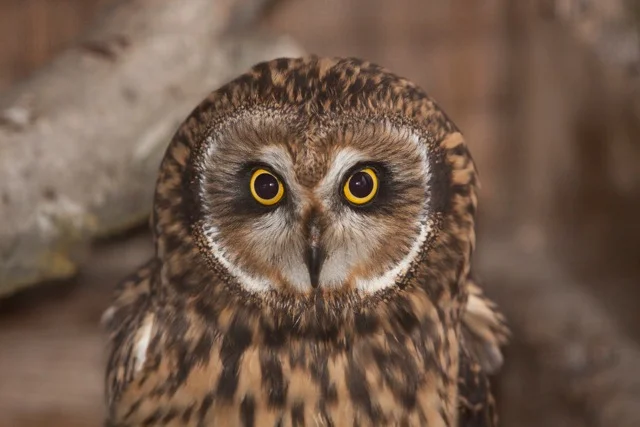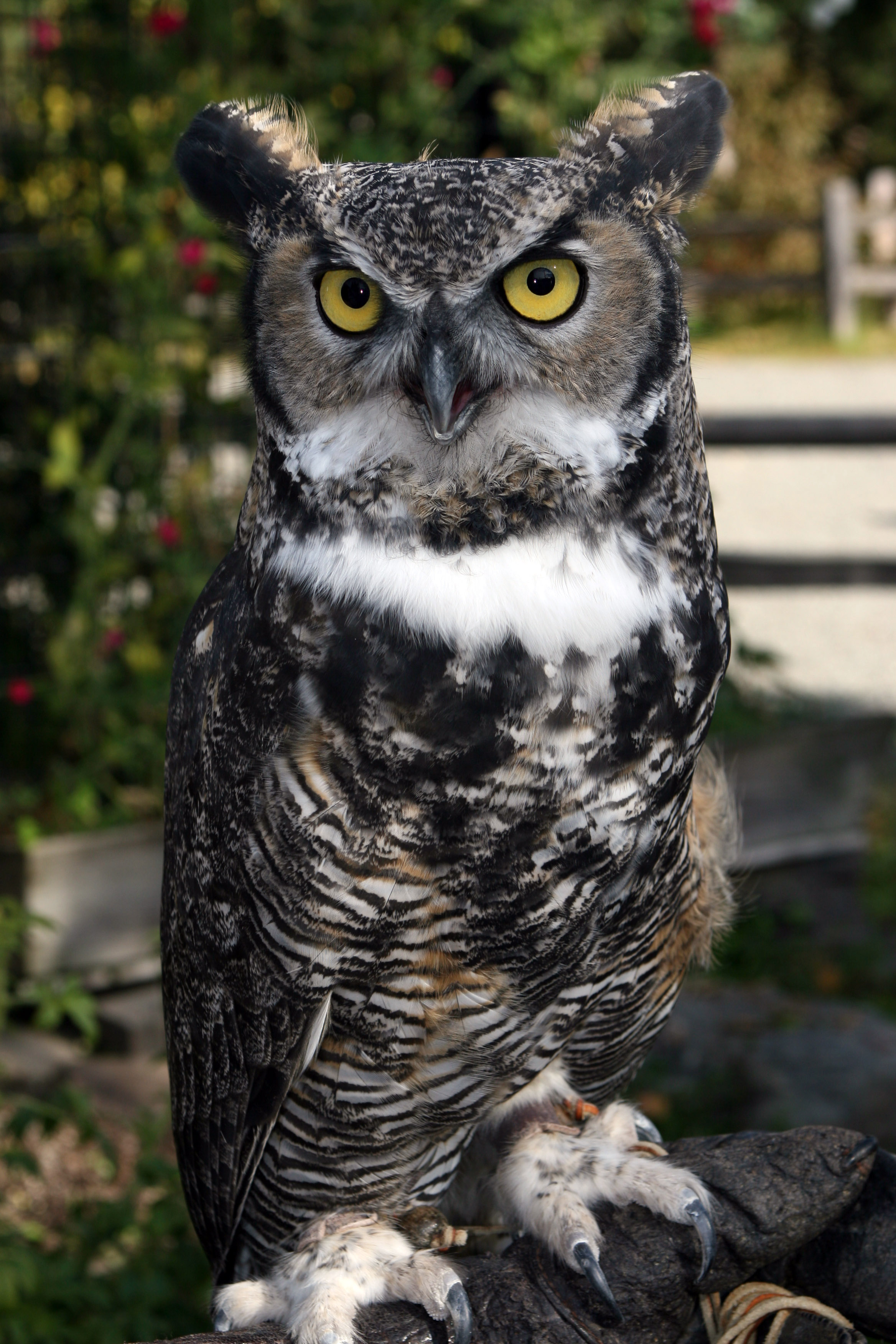Great Gray, Great Horned and Short-eared Owls
We have three owl species at the zoo: Great gray owl, great horned owl and short-eared owl. Back to animal directory.
great gray owl
Strix nebulosa
LIFE SPAN: Up to 15 years in the wild and 27 years under human managed care.
RANGE: One of the most reclusive owls in North America, not often seen although widely distributed. Ranges from Brooks Range, south to Cook Inlet, east into Canada. Has a circumpolar distribution from Norway across the boreal forest to eastern Canada.
SIZE: 19 inches tall with a wing span of 4.5 feet, weighing 2.3 to 3.5 pounds.
PHYSICAL FEATURES: A prominent white collar on the front of the neck, a distinctive facial disk and the feathers of the disk help direct sound toward the ear openings which are hidden by feathers. Their skulls are asymmetrical with bony cups around the ear openings to help detect quiet rodent sounds, allowing the owls to pinpoint the location of prey in the dark under 2 feet of snow.
FOOD: Small rodents compose over 90% of the diet while other mammals, mainly shrews, and birds make up the rest. Hunts by perching on a tree overlooking an open area. Once it locates its food, it silently glides from its perch and grabs the rodent with its talons.
BEHAVIOR: Active both day and night. Do not build nests but rely on old nests of hawks. They start visiting the nest site in March and lay 1-9 eggs during April or May, incubating for 30 days and hatching in June. During low rodent years, they may not breed. There is no evidence that they migrate in Alaska, but they may move long distances to find rodents.
CONSERVATION: Common in select areas of Alaska and is seldom seen. The main factor that limits distribution is nesting sites. Their main predator is the great horned owl. Protected by both state and federal law. One of the most sought after species for bird watchers.
great horned owl
Bubo virginianus
LIFE SPAN: 25 to 30 years under human managed care.
RANGE: Common throughout North America. Great horned owls live primarily in heavily wooded forests close to open fields and meadows where they have visibility to hunt rodents and other birds.
SIZE: May weigh up to 4 pounds. Wingspan of 36 to 60 inches.
PHYSICAL FEATURES: Great horned owls have ear openings instead of external ears like humans. They are located under feathers on either side of their dish-shaped face. This face shape allows sound waves to funnel intothe ears. Vision is their best sense, with night vision 100 times better than humans.
FOOD: They will hunt any animal they can catch and kill including porcupines, cats, and small dogs. Their typical diet in Alaska consists of small mammals like voles or squirrels and mice, along with smaller bird species.
BEHAVIOR: Breeding begins in December or January, with the owls becoming more vocal during this time. This is usually the time of year during which people hear them making the characteristic “hoo-hoo, hoo-hoo” call. They use these calls to locate and identify other owls, advertise territories and give warnings. These owls fly within 9 weeks of birth, leaving the nest by 12 weeks.
CONSERVATION: Alaska populations are stable. Protected by theMigratory Bird Treaty Act. It is illegal to kill or posses any part of a great horned owl, including feathers (unless permitted by USFWS). Threats include loss of habitat, gunshots, poisoning, and trapping.
Short-eared owl
Asio flammeus
LIFE SPAN: 15 years under human managed care.
RANGE: Commonly found in Alaska in both forest edges and open areas.
SIZE: Wingspan is between 39 and 42 inches. Average weight is 11 ounces.
PHYSICAL FEATURES: Short-eared owls are mid-sized owls with very short “ear” feather tufts. They have ear openings located on either side of their facial disk. The tawny brown coloration and streaked undersides allow these owls to stay effectively hidden in forests and tall grasses. A black patch is visible on the wrists (front of wings) in flight. The facial disk is round with the presence of white feathers that give the appearance of “eyebrows”, a very distinctive trait.
FOOD: Short-eared owls typically hunt small mammals including voles and other small rodents, some birds and insects. Short-eared owls are crepuscular hunters, meaning they are active and hunting during twilight hours. They hunt by making long sweeping flights over grasslands or watching prey from a perch and attacking in an ambush.
BEHAVIOR: Males will engage in elaborate flight displays to impress females. Clutch (brood of eggs) sizes vary depending on latitude and replacement clutches are laid in areas where predation is high. The young owls develop quickly, often wandering from the nest as early as 12 days. They leave the nest by 4 weeks of age. These owls nest on the ground in depressions among tall grass and weeds.
CONSERVATION: Short-eared owls are a species of special concern in Lower 48 states, most likely due to the widespread loss of prairie habitat. They are protected by the Migratory Bird Treaty Act which stipulates that it is illegal to harm or possess any part, including feathers (unless permitted by USFWS).



